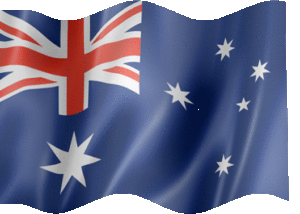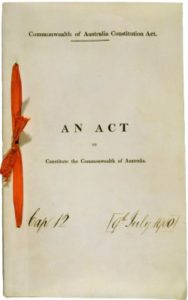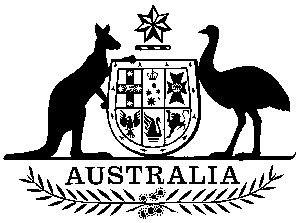Australian pride
There are three things that underpin the national pride of any country. In Australia, like most other countries, they are our Flag, our Constitution and our National Anthem.
.
AUSTRALIAN NATIONAL FLAG

The Australian National Flag (the flag) was first flown in 1901
(see also Australian National Flag Day).
It is Australia’s foremost national symbol and has become an expression of Australian identity and pride. The flag is paraded by our defence forces and displayed around the country at sporting events and by service organisations, schools, community groups and private citizens.
Symbolism
The flag has three elements on a blue background: the Union Jack, the Commonwealth Star and the Southern Cross. The Union Jack in the upper left corner represents the history of British settlement. Below the Union Jack is a white Commonwealth, or Federation, star. It has seven points representing the unity of the six states and the territories of the Commonwealth of Australia. The star is also featured on the Commonwealth Coat of Arms. The Southern Cross is shown on the flag in white. It is a constellation of five stars that can only be seen from the southern hemisphere and is a reminder of Australia’s geography.
History
In 1901 Australia’s first Prime Minister, the Rt Hon Sir Edmund Barton, announced an international competition to design a flag for the new Commonwealth of Australia. There were 32,823 entries and five nearly-identical entries were awarded equal first. The flag was flown for the first time in September 1901 at the Exhibition Building in Melbourne, which was then the seat of the federal government originally governed. In this original design the stars of the Southern Cross had different numbers of points to signify their brightness
.
AUSTRALIAN CONSTITUTION
The Australian Constitution was drafted at a series of constitutional conventions held in the 1890s. It was passed by the British Parliament as part of the Commonwealth of Australia Constitution Act 1900 (pdf)
and took effect on 1 January 1901. The Australian Constitution was put in place by our founding fathers as this fledgling country became a nation. It is what underpins our system of government and our Federal Parliament.
Get a pdf copy of the
Australian Constitution HERE
.
AUSTRALIA’S NATIONAL ANTHEM:
History of our
Australian National Anthem
The original composition of ‘Advance Australia Fair’ was written by
Peter Dodds McCormick
in 1878 and was four verses long.
In 1973 the Australia Council for the Arts held the Australian National Anthem Quest competition to find the lyrics and music for a new Australian national anthem. The competition received more than 1400 entries for lyrics and 1200 entries for music, but the judges decided the entries did not meet the high standards of Australia’s traditional songs
‘Advance Australia Fair’,
‘Waltzing Matilda’ and
‘Song of Australia’.
As a result, the Australia Council for the Arts recommended the final choice for the national anthem should be made from these three songs.
The Bureau of Statistics then ran a national poll of 60 000 people, which found ‘Advance Australia Fair’ was favoured by 51.4 per cent of people, followed by ‘Waltzing Matilda’ (19.6 per cent). In 1974 ‘Advance Australia Fair’ was adopted as the Australian National Anthem, but in 1976 ‘God Save The Queen’ was reinstated. In 1977 the Australian Electoral Office conducted another poll, which again found ‘Advance Australia Fair’ was the preferred anthem (43.6 per cent), followed by ‘Waltzing Matilda (28.45 percent).
In 1981 the National Australia Day Council recommended the Australian National Anthem consist of verses one and two of ‘Advance Australia Fair’ with some modification. On 19 April 1984 the then Governor-General, the
Rt Hon Sir Ninian M Stephen proclaimed the Australian National Anthem the tune of ‘Advance Australia Fair’ and the verses drafted by the National Australia Day Council.
The two authorised verses of the Australian National Anthem, as proclaimed in 1984, are:
Australians all let us rejoice,
For we are young and free;
We’ve golden soil and wealth for toil;
Our home is girt by sea;
Our land abounds in nature’s gifts;
Of beauty rich and rare;
In history’s page, let every stage
Advance Australia Fair
In joyful strains then let us sing,
Advance Australia Fair
Beneath our radiant Southern Cross,
We’ll toil with hearts and hands,
To make this Commonwealth of ours
Renowned of all the lands,
For those who’ve come across the seas
We’ve boundless plains to share,
With courage let us all combine
To advance Australia fair.
In joyful strains then let us sing,
Advance Australia fair.
.
COMMONWEALTH
COAT OF ARMS
First Commonwealth Coat of Arms
King Edward VII first officially granted of a coat of arms to the Commonwealth of Australia, in a Royal Warrant on 7 May 1908.
The first Coat of Arms was a simple shield of white and blue. On the shield was the Cross of St George, with five six-pointed white stars along the cross and six small escutcheons (small shields) around the edge of the shield. The shield was supported by a kangaroo and an emu standing on a grassy mound and above the shield was the crest containing the seven-pointed gold star of Federation on a wreath of white and blue. The motto ‘Advance Australia’ was inscribed at the base of the grassy mound.
Current Coat of Arms:
Commonwealth Coat of Arms (conventional)
King George V granted the second Commonwealth Coat of Arms in a Royal Warrant (PNG 231 KB) dated 19 September 1912, which includes a ‘blazon’, or official description of the Commonwealth Coat of Arms, so the Coat of Arms can be reproduced in any part of the world. The 1912 Coat of Arms is the official Commonwealth Coat of Arms.
The second Commonwealth Coat of Arms was designed because the original Coat of Arms didn’t make any reference to the states.
Commonwealth Coat of Arms (stylised)
. Australian pride. Australian pride




